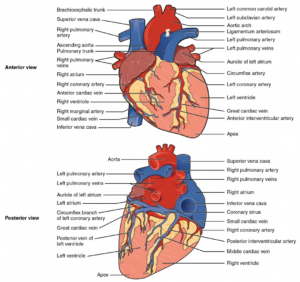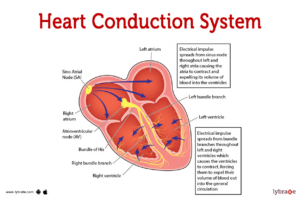Table of Contents:
- Location Of Heart In the Human Body
- Basic anatomy of the heart
- Surface Anatomy Of The Heart
- The Coverings and Layers of Heart
- Chambers of the Human Heart
- The Conducting system and Nerves supply
- Blood supply
- Relevance of understanding heart anatomy
The heart and brain are the most vital organs of the human body. Damage to either one poses a potential threat compared to other organs. Cardiac ailments affecting the heart are the largest causative factor for death. According to WHO, cardiac ailments, especially ischemic heart disease, have caused at least 13% of deaths around the world since the year 2000.
As the vital organ responsible for the circulatory function of blood throughout the body, understanding heart anatomy can help save a life in sudden cardiac emergencies. In this blog, we shall discuss the major aspects of heart anatomy.
Master ACLS Now
Get ACLS certified with confidence
Location of Heart In the Human Body
The chest area, or thorax, of the human body is home to several vital organs and anatomical structures. It is formed by the sternum (middle bone connecting ribs on either side), ribs, and thoracic vertebrae.
The thorax contains the lungs, heart, windpipe or trachea, esophagus or food pipe, and various circulatory structures. These organs are enclosed within a ribcage, which protects them from direct trauma. The anatomical heart is located in a special area called the mediastinum, which lies close to the left side of the sternum.
On either side of the heart are a pair of lungs. Within the mediastinum, the heart is located inside a special capsule or sac-like covering called pericardium. The pericardium protects the heart from direct contact with its surrounding structures and helps to maintain its proper functioning. From its surface relations, a better preview of the heart’s location can be understood.
Basic Anatomy of the Heart
To begin with the basic anatomy of the heart, it is an inverted or quadrangular pyramid-shaped highly vascular organ. Although comparable to an inverted pyramid, it has rounded edges and a tapering apex.
A more accurate comparison of the shape and size of the heart could be to a clenched fist. As a person grows, the size and shape of the heart are closely comparable to their clenched fist. Typically, its weight ranges between 250-350 gms in men and 150-300 gms in females. This weight further varies based on age, ethnicity and body weight of the individual.
To learn the detailed heart anatomy, one must know that the main parts of the heart are its 4 chambers, 4 valves, 3 types of septum and the great vessels.
Read More: How Sleep deprivation affects your heart?
Surface Anatomy of The Heart
The human heart is a 4 chambered organ with 4 borders and 5 surfaces. Understanding the borders and surfaces of the heart helps in getting detailed ideas about the precise positioning of the heart. The 4 borders or margins of the heart are:
- Superior border, formed by portions of right and left atria and great vessels.
- Inferior border, formed by the left and right ventricles
- The left border is formed by the left atrium and ventricle.
- The right border, formed by the right atrium
The surfaces of the heart are named by part of the heart that lies close to it. The 5 surfaces of the human heart are:
- The sternocostal or anterior surface, formed by the right ventricle
- The right pulmonary surface on the right side
- The left pulmonary surface on the left sight
- Diaphragmatic or inferior surface
- Posterior surface or base
The Coverings and Layers of Heart
The human heart, while it lies in the mediastinum, is enclosed in a sac called pericardium. The pericardium has 2 layers called the fibrous pericardium and the serous pericardium. The fibrous pericardium is the outermost layer of the pericardium and prevents the over-expansion of the heart. The inner layer of pericardium is the serous pericardium which has furthermore two layers. They are visceral and parietal pericardium.
While the visceral pericardium is attached to the outermost layer of the heart, the parietal pericardium is attached to the fibrous pericardium. In between these two layers lies the pericardial fluid. The pericardial fluid provides lubrication for the heart within the pericardium.
Heart Layers
Next in heart anatomy comes the layers of the heart. The heart’s musculature is made up of special tissue formed by the cardiac cells. These cells form the three layers of the heart. The 3 layers are:
- Epicardium: This is the outermost layer of the human heart. This single-cell layer functions to perform repair post-injury and cardiac development.
- Myocardium: This is the middle layer located between the epicardium and endocardium. It is majorly responsible for the heart’s contractile ability.
- Endocardium: The innermost layer of the heart musculature, which also contributes to the formation of the heart valves.
Chambers of the Human Heart
The four chambers of the human heart are the right atrium, right ventricle, left atrium, and left ventricle. The right side of the heart deals with deoxygenated blood, while the left side deals with oxygenated blood.
The atria are separated from one another by the atrial septum. The ventricles are separated from each other by the ventricular septum. A third type of septum, called atrioventricular septum, separates the atria from the ventricles.
-
The Right Atrium
This upper right-sided chamber receives deoxygenated blood from the different parts of the body through the superior and inferior vena cava and the coronary sinus. The blood from this chamber flows into the right ventricle.
A special valve called the tricuspid valve prevents blood from back flowing into the right atrium from the right ventricle. This chamber is also home to the Sino-atrial Node and Atrioventricular Node, which are responsible for the primary generation and control of electrical signals for the heart’s contraction.
-
The Right Ventricle
This lower right-sided chamber receives deoxygenated blood from the right atrium and pumps it to the lungs through the pulmonary artery for oxygenation. The Pulmonary valve present here guards the backflow of blood back into the right ventricle from the pulmonary artery.
-
The Left Atrium
This upper left-sided chamber receives oxygenated blood from the lungs through the pulmonary vein and pumps it into the left ventricle. The mitral valve or bicuspid valve guards the backflow of blood from the left ventricle into the left atrium.
-
The Left Ventricle
This lower left-sided chamber receives oxygenated blood from the left atrium and pumps it via the aorta and its branches into the different parts of the body. A special valve called the Aortic valve prevents blood from back flowing into the left ventricle from the aorta.
Inside both the ventricles, a couple of finger-like projections called papillary muscles are present. Within the heart, the tricuspid and bicuspid valves are attached to the papillary muscle through special structures called chordae tendineae.
Read More: Cardiac disease in the young: Recognizing and Understanding Early Signs
The Conducting System and Nerves supply
The human heart consists of a web or network of specialized heart tissue that can conduct electrical signals across its musculature. This network of tissues, responsible for conducting electrical impulses throughout the heart’s musculature, forms the heart’s conduction system. Its major components include the Sinoatrial Node (SA node), Atrioventricular Node (AV node), Bundle of His (atrioventricular bundle), and Purkinje fibers.
- The SA node, located in the right atrium, generates impulses that eventually lead to the heartbeat. It is also called the pacemaker of the heart.
- The electrical impulse from the SA node spreads throughout the left and right atria, causing the atria to contract and expelling their volume of blood into the ventricles.
- The part of the electrical impulses transmitted to the AV node from the SA node travels to spread along the branches of a bundle of his.
- The impulse spreads from the bundle of His throughout the left and right ventricles through Purkinje fibers.
- This causes the ventricles to contract, thus forcing them to expel the blood out into the general circulation.
In addition, the heart musculature is innervated by a special network of nerves from the autonomic nervous system, which is referred to as the cardiac plexus.
Blood Supply
A special set of arteries called coronary arteries supplies blood to the heart’s musculature. The aorta arising from the left atrium gives rise to the ascending aorta, which forms the arch of the aorta and gives off multiple branches. However, from the root of the aorta, two branches of the artery arise. They are the right coronary artery, or RCA, and the left main coronary artery, or LMCA.
- The RCA primarily supplies the right atrium and right ventricles, while its branches supply the SA node, AV node, and interventricular septum.
- The LCMA has two main branches: the left circumflex artery and the left anterior descending artery (LAD). These branches supply the left atrium and ventricle. The rest of the heart is supplied by various minor branches of the Right and left coronary arteries.
The pulmonary artery and vein contribute to pulmonary circulation. On the other hand, the vena cava and aorta primarily contribute to systemic circulation.
The Bottom Line
Being one of the most alarming medical emergencies, cardiac ailments have caused the death of nearly 702,880 individuals in 2022 in the USA, according to the CDC. A vast majority of these deaths have been as a result of sudden cardiac arrests and heart attacks. When sudden cardiac arrest occurs due to unexpected loss of cardiac function, heart attacks occur due to blockage or interruption in blood flow to the heart musculature.
In either of these conditions, providing CPR at that instant is the primary line of management. To carry out CPR with accuracy, apart from the skillsets, one must also know the real heart anatomy. An individual with CPR training can not only promise a better survival rate from these cardiac emergencies. But also promise, it lowers long-term complications, thus offering neurological advantages.








